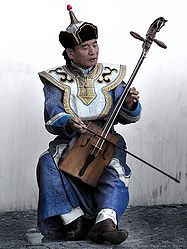- Morin khuur
-
Морин хуур (Morin khuur) 
Sambuugiin Pürevjav of Altai Khairkhan performing in Paris in 2005.String instrument Other names Matouqin, Шоор (Shoor), Икил (Ikil) Classification Bowed string instrument Related instruments Byzaanchy, Igil, Gusle, Kobyz More articles Music of Mongolia The morin khuur (Mongolian: морин хуур) is a traditional Mongolian bowed stringed instrument. It is one of the most important musical instruments of the Mongol people, and is considered a symbol of the Mongolian nation. The morin khuur is one of the Masterpieces of the Oral and Intangible Heritage of Humanity identified by UNESCO. It produces a sound which is poetically described as expansive and unrestrained, like a wild horse neighing, or like a breeze in the grasslands.
Contents
Name
The full Classical Mongolian name for the morin khuur is morin-u toloγai tai quγur (which in modern Khalkh cyrillic is Морин толгойтой хуур) meaning fiddle with a horse's head. In western Mongolia it is known as ikil (Mongolian: икил—not to be confused with the similar Tuvan igil)—while in eastern Mongolia it is known as shoor (Mongolian: Шоор).[1] It is known in Chinese as matouqin (Chinese: 馬頭琴).
Construction
The instrument consists of a trapezoid wooden-framed sound box to which two strings are attached. It is held nearly upright with the sound box in the musician's lap or between the musician's legs. The strings are made from hairs from nylon or horses' tails ,[2] strung parallel, and run over a wooden bridge on the body up a long neck, past a second smaller bridge, to the two tuning pegs in the scroll, which is usually carved into the form of a horse's head.
The bow is loosely strung with horse hair coated with larch or cedar wood resin, and is held from underneath with the right hand. The underhand grip enables the hand to tighten the loose hair of the bow, allowing very fine control of the instrument's timbre.
The larger of the two strings (the "male" string) has 130 hairs from a stallion's tail, while the "female" string has 105 hairs from a mare's tail. Traditionally, the strings were tuned a fifth apart, though in modern music they are more often tuned a fourth apart, usually to B-flat and F. The strings are stopped either by pinching them in the joints of the index and middle fingers, or by pinching them between the nail of the little finger and the pad of the ring finger.
Traditionally, the frame is covered with camel, goat, or sheep skin, in which case a small opening would be left in back. But since the 1970s, new all-wood sound box instruments have appeared, with carved f-holes similar to European stringed instruments.[3]
Morin khuur vary in form depending on region. The Instruments from central Mongolia tend to have larger bodies and thus possess more volume than the smaller-bodied instruments of Inner Mongolia. In Tuva, the morin khuur is sometimes used in place of the igil.
Origin
Even though the morin huur does not own a long history,[4] its direct predecessor Chuurqin has a long history. In Tang dynasty (600s~800s), when the ethnic Mongols were still a branch of Shiwei people, there appeared to be records of huqin. In Northern Song dynasty, when the Mongols are forming, horse-tail huqin (馬尾胡琴) appears.[5] Since then, the chuur fiddle has been separated from general huqin till now.
One legend about the origin of the morin khuur is that a shepherd named Namjil the Cuckoo received the gift of a flying horse; he would mount it at night and fly to meet his beloved. A jealous woman had the horse’s wings cut off, so that the horse fell from the air and died. The grieving shepherd made a horsehead fiddle from the now-wingless horse's skin and tail hair, and used it to play poignant songs about his horse.
Another legend credits the invention of the morin khuur to a boy named Sükhe (or Suho). After a wicked lord slew the boy's prized white horse, the horse's spirit came to Sükhe in a dream and instructed him to make an instrument from the horse's body, so the two could still be together and neither would be lonely. So the first morin khuur was assembled, with horse bones as its neck, horsehair strings, horse skin covering its wooden soundbox, and its scroll carved into the shape of a horse head.
Chinese history credits the evolution of the matouqin from the xiqin (奚琴), a family of instruments found around the Shar Mören River valley (not to be confused with the Yellow River) in what is now Inner Mongolia. It was originally associated with the Xi people. In 1105 (during the Northern Song Dynasty), it was described as a foreign, two-stringed lute in an encyclopedic work on music called Yue Shu by Chen Yang. In Inner Mongolia, the matouqin is classified in the huqin family, which also includes the erhu.
The fact that most of the eastern Turkic neighbors of the Mongols possess similar horse hair instruments (such as the Tuvan igil, the Kazakh kobyz, or the Kyrgyz Kyl kyyak), though not western Turkic, may point to a possible origin amongst peoples that once inhabited the Mongolian Steppe,[citation needed] and migrated to what is now Tuva, Kazakhstan and Kyrgyzstan.
See also
References
- ^ Монгол ардын хөгжмийн зэмсэг. Accessed 23 April 2010.
- ^ "Morin khuur". www.silkroadproject.org. http://www.silkroadproject.org/MusicArtists/Instruments/Morinkhuur/tabid/318/Default.aspx. Retrieved 2010-04-24.
- ^ CD booklet notes, Mongolia: Traditional Music, 1991, Auvidis-UNESCO D 8207
- ^ http://www.sin80.cn/class/shebei/200906/06153601.html
- ^ Dream Pool Essays by Shen Kuo
- Marsh, Peter K. (2004). Horse-Head Fiddle and the Cosmopolitan Reimagination of Mongolia. ISBN 041597156X.
External links
- Mongolian art and culture traditional instruments
- Embassy of Mongolia Seoul Mongolian culture, including the morin khuur.
Traditional Chinese musical instruments Silk (string) Plucked Guqin · Se · Guzheng · Konghou · Pipa · Sanxian · Ruan · Liuqin · Yueqin · Qinqin · Duxianqin Bowed Huqin · Erhu · Zhonghu · Gaohu · Banhu · Jinghu · Erxian · Tiqin · Tihu · Yehu · Tuhu · Jiaohu · Sihu · Sanhu · Zhuihu · Zhuiqin · Leiqin · Dihu · (Xiaodihu · Zhongdihu · Dadihu) · Gehu · Diyingehu · Laruan · Matouqin · Yazheng Struck Yangqin · Zhu Bamboo (woodwind) Flutes Dizi · Xiao · Paixiao · Koudi Oboes Guan · Suona Free-reed pipes Bawu · Mangtong Gourd (woodwind) Sheng · Yu · Hulusi · Hulusheng Percussion Wood Muyu · Paiban · Guban Stone Bianqing Metal Bianzhong · Fangxiang · Luo · Yunluo Clay Fou Hide Daigu · Bangu · Paigu · Tanggu Others Xun · Gudi · Lusheng · Kouxian Huqin instrument family Erhu • Gaohu • Banhu • Jinghu • Zhonghu • Yehu • Erxian • Tiqin • Daguangxian • Datong • Datongxian • Hexian • Huluhu • Maguhu • Tuhu • Jiaohu • Zhuihu • Zhuiqin • Leiqin • Sihu • Sanhu • Dahu • Dihu • (Xiaodihu • Zhongdihu • Dadihu) • Cizhonghu • Gehu • Diyingehu • Laruan (Dalaruan) • Paqin • Xiqin • Niutuiqin (niubatui) • Matouqin • Aijieke • SataerCategories:- Bowed instruments
- Masterpieces of the Oral and Intangible Heritage of Humanity
- Mongolian musical instruments
- Necked lutes
Wikimedia Foundation. 2010.


